
Wireless USB Print Server
Share your USB printers wirelessly with your networked computers
User Manual
F1UP0001

Wireless USB Print Server
Share your USB printers wirelessly with your networked computers
User Manual
F1UP0001

TABLE OF CONTENTS
Introduction . . . . . . . . . . . . . . . . . . . . . . . . . . . . . . . . . . . . . . . . . . . . . . .1
System Requirements . . . . . . . . . . . . . . . . . . . . . . . . . . . . . . . . . . . . . .1
Package Contents . . . . . . . . . . . . . . . . . . . . . . . . . . . . . . . . . . . . . . . . .1
Overview . . . . . . . . . . . . . . . . . . . . . . . . . . . . . . . . . . . . . . . . . . . . . . . . . .2
Features . . . . . . . . . . . . . . . . . . . . . . . . . . . . . . . . . . . . . . . . . . . . . . .2 Applications and Advantages . . . . . . . . . . . . . . . . . . . . . . . . . . . . . . . . .2 Product Specifications . . . . . . . . . . . . . . . . . . . . . . . . . . . . . . . . . . . . . .3 Knowing your Print Server . . . . . . . . . . . . . . . . . . . . . . . . . . . . . . . . . . .4
Connecting the Print Server Using the Setup Wizard . . . . . . . . . . . . . . . . . . . .6 Setup for Advanced Users . . . . . . . . . . . . . . . . . . . . . . . . . . . . . . . . . . . . . .8 Web Configuration . . . . . . . . . . . . . . . . . . . . . . . . . . . . . . . . . . . . . . . . . .12
Accessing Web Configuration Menus . . . . . . . . . . . . . . . . . . . . . . . . . . . .12
Home Page . . . . . . . . . . . . . . . . . . . . . . . . . . . . . . . . . . . . . . . . . . . .13
Login Screen . . . . . . . . . . . . . . . . . . . . . . . . . . . . . . . . . . . . . . . . . . .13
IP Address . . . . . . . . . . . . . . . . . . . . . . . . . . . . . . . . . . . . . . . . . . . . .14
Channel and SSID . . . . . . . . . . . . . . . . . . . . . . . . . . . . . . . . . . . . . . . .15
Encryption . . . . . . . . . . . . . . . . . . . . . . . . . . . . . . . . . . . . . . . . . . . . .16
Site Survey . . . . . . . . . . . . . . . . . . . . . . . . . . . . . . . . . . . . . . . . . . . .21
Print Server Configuration . . . . . . . . . . . . . . . . . . . . . . . . . . . . . . . . . . .22
Upgrade Firmware . . . . . . . . . . . . . . . . . . . . . . . . . . . . . . . . . . . . . . . .23
System Settings (Changing Password) . . . . . . . . . . . . . . . . . . . . . . . . . . .24
Printing to Multiple Print Servers . . . . . . . . . . . . . . . . . . . . . . . . . . . . . . . .25
Adding a Belkin Port Monitor and Configuring It for a Specific Print Server . . . . . .25
Belkin Port Monitor Advanced Menu . . . . . . . . . . . . . . . . . . . . . . . . . . . . . .28
Adding a Second Belkin Port Monitor and Configuring It for a Specific
Print Server . . . . . . . . . . . . . . . . . . . . . . . . . . . . . . . . . . . . . . . .29
Using the Print Server for FTP Printing . . . . . . . . . . . . . . . . . . . . . . . . . . . .32
Sending Print Jobs to Printers Connected to the Print Server Using FTP . . . . .32
Troubleshooting . . . . . . . . . . . . . . . . . . . . . . . . . . . . . . . . . . . . . . . . . . . .35
Technical Support . . . . . . . . . . . . . . . . . . . . . . . . . . . . . . . . . . . . . . . . . . .38
Information . . . . . . . . . . . . . . . . . . . . . . . . . . . . . . . . . . . . . . . . . . . . . . .39

INTRODUCTION
Thank you for purchasing the Belkin Wireless USB Print Server. Now you can share your
System Requirements
???Printer compatible with USB 1.1
???USB cable for each printer
???802.11g or 802.11b wireless network
???PC with Windows?? 98SE, Me, 2000, XP
Package Contents
???Belkin 802.11g Wireless USB Print Server
???Ethernet cable (not needed for wireless operation)
???Installation Software CD
???User Manual
???Quick Installation Guide
???Registration Card
1

OVERVIEW
Features
This device complies with the IEEE 802.11g standard in order to communicate with other 802.11b- and
???Integrated,
???Wireless interface compliance with the IEEE 802.11g standard products
???Ethernet interface, for operation in virtually all Ethernet networks
???64- or
???Support for both Infrastructure and
???Data rate of up to 54Mbps
???Easy installation and use
???External antenna
???LEDs: Power, Ethernet link, Wireless, Status, and Error
Applications and Advantages
???Wireless printing around the home or office
Offers the freedom of printing from networked PCs without cables.
???Connection rates of up to 54Mbps (802.11g)
Provides immediate,
???Compatibility with 802.11b products
802.11g wireless LAN solutions are
???
Enables printer sharing in buildings with solid or finished walls, or open areas where wiring is difficult to install.
???Frequently changing environments
Adapts easily in offices or environments that frequently rearrange or change locations.
???Temporary LANs for special projects or peak time
Sets up temporary networks such as at trade shows, exhibitions, and construction sites, which need networks on a
2

OVERVIEW
companies that need additional printers for a peak activity period.
???SOHO (Small Office/Home Office) networking needs
Provides easy and quick small network installations that SOHO users need.
Product Specifications
Standards:
IEEE 802.3
IEEE 802.3u
IEEE 802.11g
IEEE 802.11b
3

OVERVIEW
Knowing your Print Server
4

OVERVIEW
a b c
a. Printer 1/Printer 2
These ports are used to connect one or two USB printers.
Note: These ports cannot be expanded using a USB hub.
b. Ethernet Port
This port is used to connect the Print Server to an Ethernet network via CAT5 cable.
Note: Using this port will automatically disable wireless functionality in the Print Server.
c.Reset/Test Button (3 functions)
Print Page: For most printers, this function results in a test page to be printed. The test page will include Print Server settings including the IP address and other information that might be handy for troubleshooting the Print Server. To print test page, depress the Reset/Test button momentarily.
WARNING: Some printers do not support this function.
Reset: To reset or reboot the Print Server to existing settings, depress the Reset/Test button for five or more seconds.
Restore Factory Defaults: To restore the Print Server to factory defaults, depress the Reset/Test button for 10 seconds while powering up the Print Server.
5

CONNECTING THE PRINT SERVER USING THE SETUP WIZARD
Make sure that each computer can print to the USB printer before installing the Wireless USB Print Server.
1.Connect your printer directly to each computer on the network and install USB printer drivers (see your printer documentation for detailed instructions). The Print Server requires that the correct drivers are loaded and working (printing) before the Print Server is installed.
When installing printer drivers, install as:
???Local printer, not network printer
???USB port
???Not to be shared
???Default printer for all printing (if desired)
Note: Verify functionality on each computer by printing a test page prior to moving to the next installation step.
2.Insert the Print Server Setup Wizard CD into your
Note: If the Print Server Setup Wizard does not start up automatically, select your
3.The Wizard will start.
Note: The Wizard will remind installer that step 1 needs to be done before continuing. If step 1 is complete, click ???Next??? to proceed. If not, please stop Wizard and complete step 1 for all computers.
6

CONNECTING THE PRINT SERVER USING THE SETUP WIZARD
4.Follow instructions from each screen of the Print Server Setup Wizard.
5.When you see the following screen, installation is complete for that PC. Click ???Quit??? and remove the CD from your computer.
Important: Repeat Steps
7. Enjoy your Print Server!
7
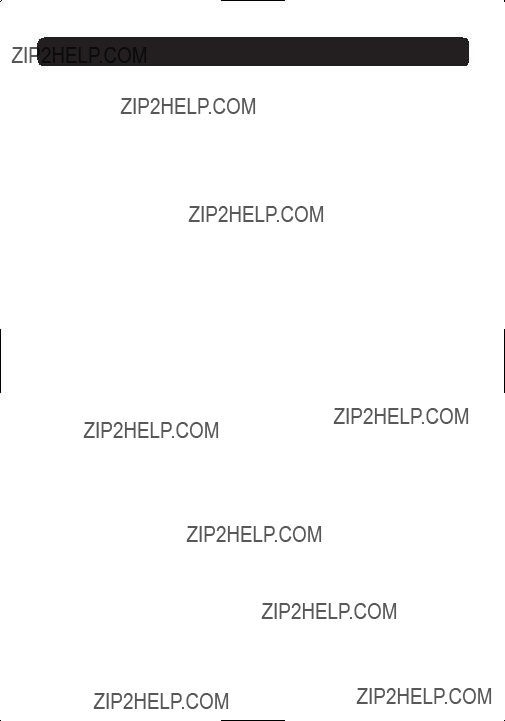
SETUP FOR ADVANCED USERS
Install Print Drivers
Be sure to install the necessary print drivers on each computer that will be accessing the Print Server.
Set Up Print Server
1.Plug your printer (power on) into the Print Server.
2.Power up the Print Server within wireless range of your 802.11g or 802.11b wireless network.
3.Allow approximately one minute for the Print Server to boot.
4.Verify that the Status light is illuminated and that the Error light is not illuminated.
5.Determine the Print Server???s IP address, using one of the following methods:
a)New Print Servers are configured to receive IP addresses dynamically. If your network has a DHCP server, the Print Server will obtain an IP address from your network. If the DHCP server supports a client list, the client list will list the IP address assigned to the Print Server. If a DHCP server is not available, after 1.5 minutes the Print Server will revert to to 192.168.2.253.
b)If the Print Server has been configured previously, then it will have been set to a static IP address that could be different for
every network.
Note: Restoring factory defaults on the Print Server by holding in the reset button for 10 seconds while repowering the Print Server will restore the IP address to dynamic.
c)Run the program ???PSF.exe??? from the Installation CD. This will find the IP address and link automatically to the
d)Go to the last step of the Print Server Installation Wizard, which has an Advanced button that finds the IP address and links automatically to the
8

SETUP FOR ADVANCED USERS
6.Verify that the computer is in the same subnet as the Print Server (The first three octets of the IP addresses are the same).
7.Type the Print Server???s IP address into your Internet browser from any computer. For example, if your IP address is 192.168.2.225, type ???192.168.2.225??? (do not type in anything else such as ???http://??? or ???www???). Then press the ???Enter??? key.
8.Clicking the ???Login??? button or clicking on any one of the links on the home page will take you to the login screen. The Print Server ships with no password entered. In the login screen, leave the password blank and click ???Submit??? to log in.
9.Set the SSID of your wireless network by clicking ???Channel and SSID??? (see ???Web Interface ??? Channel and SSID??? for more info).
10.Set the IP address for the Print Server by clicking ???IP Address??? (see ???Web Interface ??? IP Address??? for more info).
11.Set encryption for the Print Server (if desired) by clicking ???Encryption???.
12.Cycle power on the Print Server to reboot it to the new configurations.
9

SETUP FOR ADVANCED USERS
Configure Computers to Print to the Print Server
1.Install Port Monitor software on each computer by running ???instport.exe??? from the CD.
2.Configure the Belkin Port Monitor on each computer printer driver to point to the correct Print Server as follows:
a)In Windows, select the printer???s properties for the printer connected to the Print Server and select the ???Port??? tab, select the Belkin port, and click ???Configure Port...???.
b) On the ???Belkin Port: Properties??? window, click ???Locate Servers???.
c)On the ???Available Servers??? window, select the Print Server you want to print to.
10

SETUP FOR ADVANCED USERS
d)Click ???OK??? to close. On the ???Belkin Port: Properties??? window, the name of the Print Server you selected will appear. Click ???OK??? to close.
e)On the Ports tab, disable bidirectional support if currently enabled. Click ???Apply???.
f)Click ???OK??? to close.
g)If there is a second printer connected to the Print Server, select the properties for that printer and click the ???Ports??? tab; select the Belkin port that was just configured.
Note: If more than one Print Server is available on your network, refer to the section ???Printing to Multiple Print Servers???.
11

WEB CONFIGURATION
Accessing the Web Configuration Menus
1.Power up the Print Server that is within wireless range of your wireless network or is connected to your network using an Ethernet cable.
2.Allow approximately one minute for the Print Server to boot and obtain an IP address.
3.Determine the Print Server???s IP address, using one of the following methods:
a)New Print Servers are configured to receive IP addresses dynamically. If your network has a DHCP server, the Print Server will obtain an IP address from your network. If the DHCP server supports a client list, the client list will list the IP address assigned to the Print Server. If a DHCP server is not available, after 1.5 minutes the Print Server will revert to 192.168.2.253.
b)If the Print Server has been configured previously, then it will have been set to a static IP address that could be different for every network.
Note: Restoring factory defaults on the Print Server by holding in the reset button for 10 seconds while repowering the Print Server will restore the IP address to dynamic.
c)Run the program ???PSF.exe??? from the Installation CD. This will find the IP address and link automatically to the
d)Go to the last step of the Print Server Installation Wizard, which has an Advanced button that finds the IP address and links automatically to the
4.Type the Print Server???s IP address into your Internet browser from any computer. For example, if your IP address is 192.168.2.225, type ???192.168.2.225??? (do not type in anything else such as ???http://??? or ???www???). Then press the ???Enter??? key.
12

WEB CONFIGURATION
Web Interface ??? Home Page
After entering the IP address of the Print Server, you will see the screen illustrated below. This page shows most critical configuration information for the Print Server. To modify settings, choose a topic from the menu on the left of the screen.
Web Interface ??? Login Screen
Clicking on any menu item will cause a login prompt to appear. If a password has been set previously, enter it here. New Print Servers ship without passwords; if this is the case, click ???Submit??? to continue.
13

WEB CONFIGURATION
Web Interface ??? IP Address
This menu allows the user to set a Static IP address, or to set the Print Server to obtain an IP address automatically as a DHCP client. Although Belkin designs the Print Server to obtain an IP address automatically, running the Wizard will change the IP address to static. Static is the recommended method of operation, since the computer will be configured to print to a specific IP address which, if changed, would make the Print Server inoperable.
Note: When choosing an IP address manually, be sure to choose a unique IP address in the same domain (first three sets of digits the same) as the gateway of your network.
14
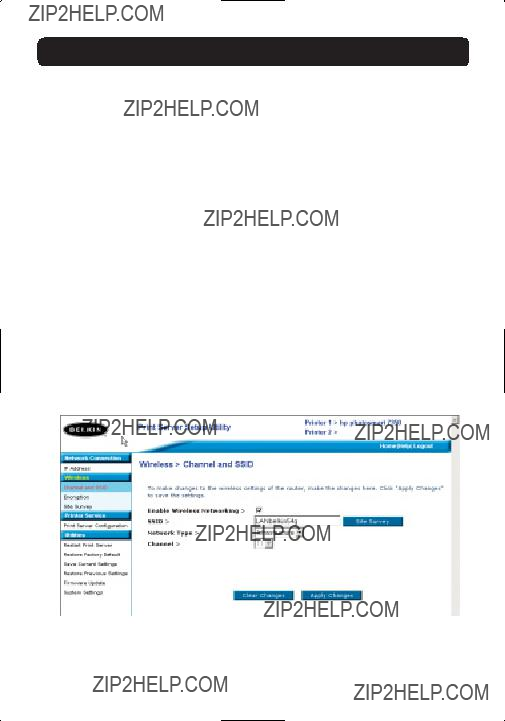
WEB CONFIGURATION
Web Interface ??? Channel and SSID
This menu allows the user to program the wireless settings.
??????Enable Wireless Networking??? is on by default. Connecting the Print Server via an Ethernet cable to the network will automatically disable wireless networking.
??????SSID??? is the wireless name of your network. The default setting is ???ANY???. This allows the Print Server to connect to the first wireless network it sees. Running the Wizard automatically changes ???ANY??? to the network SSID found during the setup procedure.
??????Network Type??? refers to either an Infrastructure or
??????Channel??? is only applicable for
???To see wireless networks in your area and choose the one you wish to connect to, see ???Web Interface ??? Site Survey??? on the next page.
15
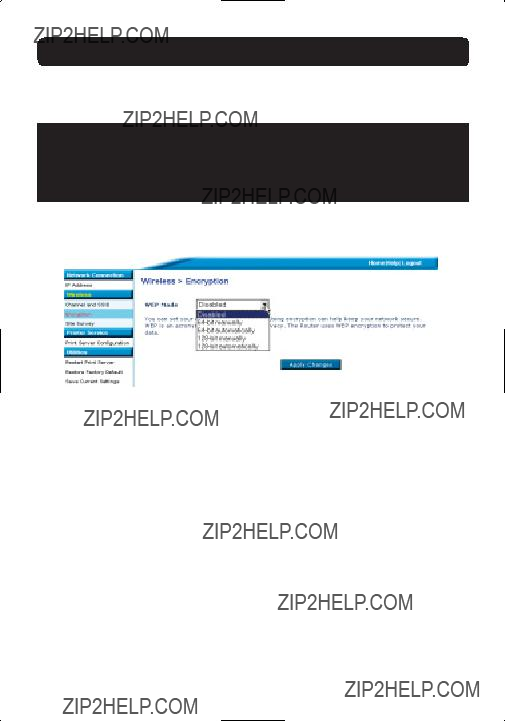
WEB CONFIGURATION
Web Interface ??? Encryption
IMPORTANT: Use the following encryption information only if your network is encrypted. If it is not, leave the encryption mode (???WEP Mode??? in the dialog box illustrated below) set to its
default, ???Disabled???.
This menu allows you to activate your Print Server???s encryption feature, which is determined by your existing LAN encryption setting.
To set encryption for your Print Server choose the matching setting in the dialog box above. The following briefly explains the various settings your software makes available:
???
???
???
16

WEB CONFIGURATION
???
WEB Interface ??? Encryption
This menu allows the user to enter keys for
To set encryption for your Print Server:
???WEP Mode: Select encryption mode from the
???WEP Key: Select the appropriate Key number and enter hex digits into all 20 fields consistent with your existing wireless network settings.
(Warning: Any inconsistencies with your network???s settings will cause the Print Server not to connect to your wireless network).
???Authentication Mode: Default is ???open + shared???, which operates with all
???Apply Changes: Click this button to complete your settings.
NOTE: After changing encryption settings, the Print Server must be restarted
17

WEB CONFIGURATION
WEB Interface ??? Encryption
This menu allows the user to enter keys for
This mode is exactly like
???Pass Phrase: Entering a phrase here, for example ???Jack and Jill went up the
hill??? will result in automatic generation of hex keys. (Note: Write these down for reference as they must be typed into other network devices [your router] manually for all to interoperate.)
???Apply Changes: Click this button to complete your settings.
NOTE: After changing encryption settings, the Print Server must be restarted
18
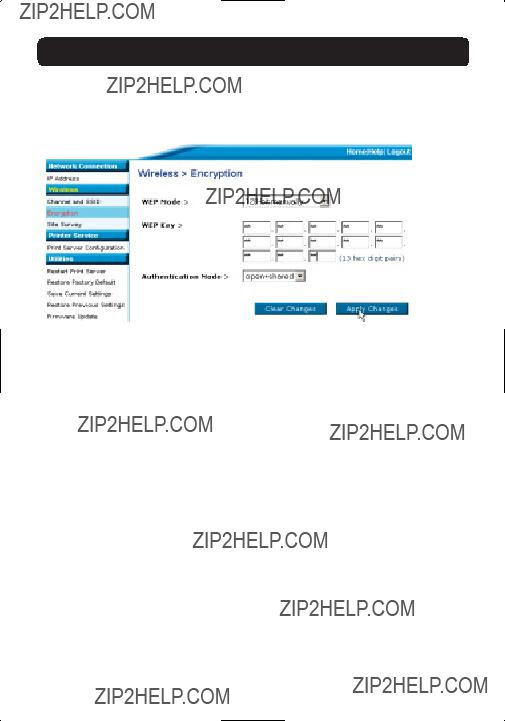
WEB CONFIGURATION
WEB Interface ??? Encryption
This menu allows the user to enter keys for
To set
???WEP Mode: Select encryption mode from the
???WEP Key: Enter hex digits into all 13 fields consistent with your existing
wireless network settings. (Warning: Any inconsistencies with your network???s settings will cause the Print Server not to connect to your existing wireless network).
???Authentication Mode: Default is ???open + shared???, which operates with all
???Apply Changes: Click this button to complete your settings.
NOTE: After changing encryption settings, the Print Server must be restarted
19

WEB CONFIGURATION
WEB Interface ??? Encryption
This menu allows the user to enter keys for
This mode is exactly like
???Pass Phrase: Entering a phrase here, for example ???Jack and Jill went up the
hill??? will result in automatic generation of hex keys. (Note: Write these down for reference as they must be typed into other network devices [your router] manually for all to interoperate.)
???Apply Changes: Click this button to complete your settings.
NOTE: After changing encryption settings, the Print Server must be restarted
20

WEB CONFIGURATION
Web Interface ??? Site Survey
This menu allows the user to see all wireless networks in the area and connect to one.
21

WEB CONFIGURATION
Web Interface ??? Print Server Configuration
This menu allows the user to modify the following parameters:
???Print Server Name: This field identifies the Print Server by name, and each Print Server has a unique name. Unique names are critical in a network with more than one Print Server. If the user wishes to change the name, make sure to use unique names.
???Raw Printing: This feature allows clients to print to the Print Server using the standard TCP/IP printer port built into Windows XP and 2000 instead of the Belkin Port Monitor. Using Raw Printing requires the user to configure all port parameters manually and is not recommended for users unfamiliar with TCP/IP printing.
???FTP Printing: This feature enables the printer to receive print jobs sent by FTP (see FTP Printing for detailed instructions). Disabling this feature will prevent FTP jobs.
22

WEB CONFIGURATION
Web Interface ??? Upgrade Firmware
This menu allows the user to upgrade the Print Server???s firmware. Before running this application, download the new firmware from the Belkin website at www.belkin.com. Be careful to take note of the location of the downloaded file on your computer???s hard disk. After downloading, click ???Browse??? on the screen shown below, select the file name of the downloaded firmware, then click ???Apply Changes???. The firmware upgrade will take a few minutes.
NOTE: Do not interrupt the process by removing power from the Print Server or you could cause permanent damage to the device.
23

WEB CONFIGURATION
Web Interface ??? System Settings (Changing Password)
The Print Server ships with NO preset password. If you wish to set a password for greater security, be sure to choose a password that you will remember, and make a note of it. This utility will require you to enter the new password twice. If you are entering a password for the first time, leave the ???current??? password field blank. Press ???Apply Changes??? when done.
The Web page
24
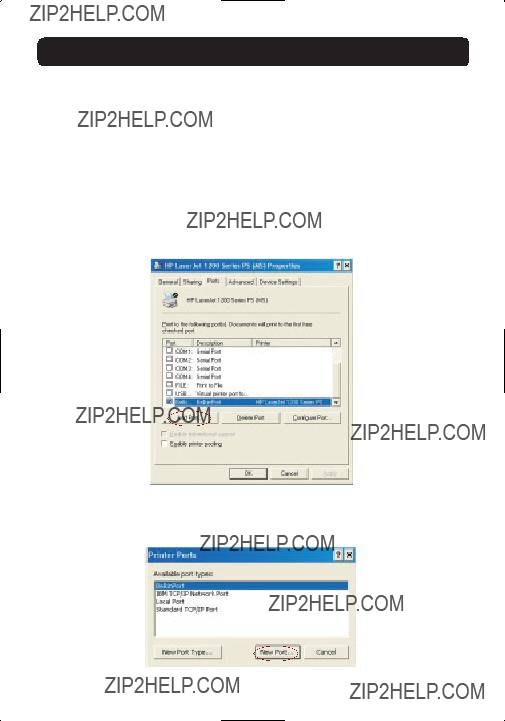
PRINTING TO MULTIPLE PRINT SERVERS
If more than one Print Server is available on your network, and some computers need to be able to print to more than one Print Server, you will need to install the included Belkin Port Monitor (a virtual printer port) software on your PC. The Belkin Port Monitor can then be configured to select different Print Servers on your network to handle specific print jobs.
Adding a Belkin Port Monitor and Configuring It for a Specific Print Server
1.In Windows, select the printer???s properties and select the ???Ports??? tab.
2.Click ???Add Port???.
A window showing the printer ports installed on the PC will open. Select ???Belkin Port??? and, in the ???Printer Ports??? window, click ???New Port???.
25

PRINTING TO MULTIPLE PRINT SERVERS
3.In the ???Enter New Port??? window, enter a unique name for the port and click ???OK???.
4.Click ???Close??? on the ???Printer Ports??? window.
5.On the ???Ports??? tab, select the newly created port; click ???Configure Port???.
6.On the next window (Belkin Port 2: Properties), click the ???Locate Servers??? button.
26

PRINTING TO MULTIPLE PRINT SERVERS
7.On the ???Available Servers??? window, select the Print Server to which you want to print.
8.Click ???OK??? to close. In the ???Belkin Port 2: Properties??? window, the name of the Print Server you selected will appear in the window.
9.Click ???OK??? to close.
10.Repeat these steps for each additional Print Server on your network.
Warning: When configuring the Port Monitor to send jobs to a specific Print Server, make sure that the correct port is selected for the printer driver in Windows and that the corresponding printer is actually connected to the Print Server that the port is indicating. Mismatching printer drivers, ports, and Print Servers will result in failed print jobs or error prints of multiple pages of indiscernible characters.
27

BELKIN PORT MONITOR ADVANCED MENU
In most cases, the Belkin Port Monitor (a virtual printer port) software will be automatically installed and configured by the Print Server Setup Wizard. Some advanced users may choose to manually configure the Belkin Port Monitor software. This can be achieved by using the Belkin Port Monitor???s Advanced Menu, which allows the user to enter a specific Print Server???s IP address and to designate a specific printer or ???queue??? for print jobs connected to that Print Server. The Advanced Menu features help when there is more than one Print Server available on your network, and when print jobs fail because the Port Monitor cannot determine the name of the printer.
Opening the Belkin Port Monitor Advanced Menu
1.In Windows, select the printer???s properties and select the ???Ports??? tab, select the Belkin Port, and click ???Configure Port???.
2. In the ???Belkin Port: Properties??? window, click the ???Advanced??? tab.
28

BELKIN PORT MONITOR ADVANCED MENU
3.The Advanced Menu has fields to enter the Print Server???s IP address and the queue name and the port number.
Note: The port number field by default is 515. In most cases, the port number should not be changed.
Adding a Second Belkin Port Monitor and Configuring It for a Specific Print Server
1. In Windows, select the printer???s properties and select the ???Ports??? tab.
29
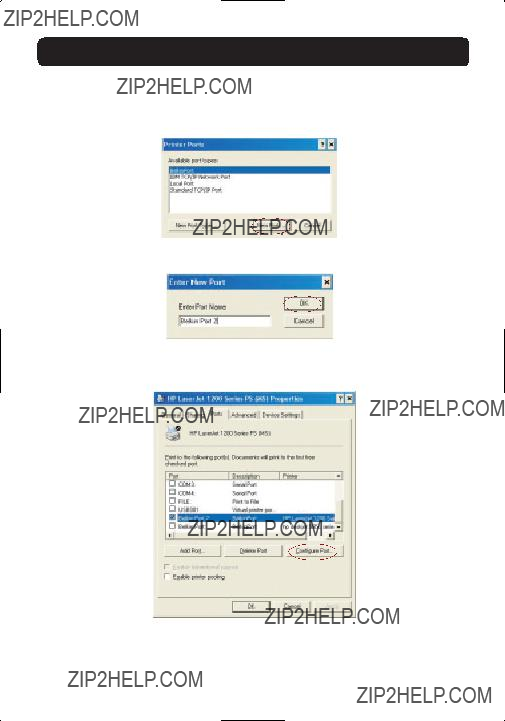
BELKIN PORT MONITOR ADVANCED MENU
2.Click ???Add Port???. A window showing the printer ports installed on the PC will open. Select ???Belkin Port??? and click ???New Port???.
3.On the ???New Port??? window, enter a unique name for the port and click ???OK???.
4.Click ???Close??? on the ???Printer Ports??? window.
5.On the ???Ports??? tab, select the newly created port and click ???Configure Port???.
6. Click the ???Advanced??? tab.
30

BELKIN PORT MONITOR ADVANCED MENU
7.Add the Print Server???s IP address and the queue name of the printer you want to select for the port. The queue name ???lp1??? will point the port to the printer connected to the printer 1 USB port on the Print Server. The queue name ???lp2??? will point the port to the printer connected to the printer 2 USB port on the Print Server.
8. Click ???OK??? to close.
Warning: When manually configuring the Port Monitor to send jobs to a specific printer, make sure that the correct printer driver is selected and that the Port Monitor???s queue name corresponds to the USB port that the printer is connected to on the Print Server. Mismatching the drivers or queue names will result in failed print jobs or error prints of multiple pages of indiscernible characters.
31

USING THE PRINT SERVER FOR FTP PRINTING
Sending Print Jobs to Printers Connected to the Print Server Using FTP
1. In Windows, select the printer???s properties.
2. Set the printer port to ???File???, click ???Apply???.
32

USING THE PRINT SERVER FOR FTP PRINTING
3.Print the document using the printer that you configured. A dialogue box will open prompting you to name the print file. After naming the file, click ???OK???. A file will be saved to the user???s default Windows directory (typically ???C:\??? or ???C:\Documents and Settings\<user???s name>???).
4.On the Windows desktop, click ???Start>Run??? and type in ???cmd??? for Windows XP and 2000 or ???command??? for Windows 98SE and Me; click ???OK??? to open a
33
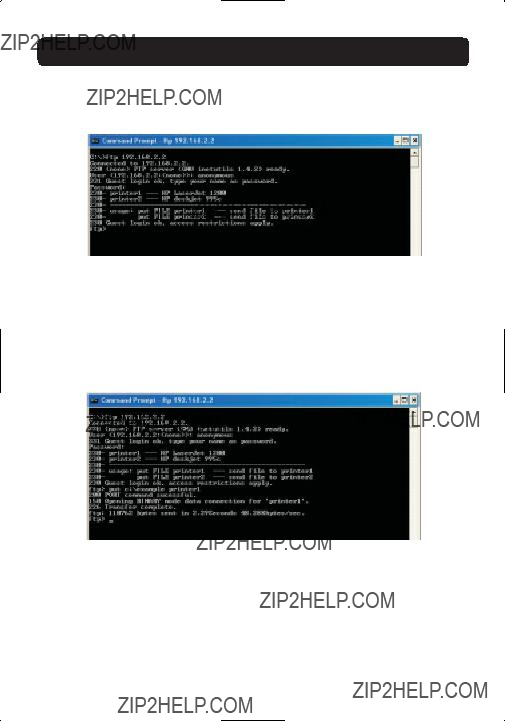
USING THE PRINT SERVER FOR FTP PRINTING
5.At the prompt, type ???ftp??? followed by the IP address of the Print Server; press the ???Enter??? key to create an FTP connection with the Print Server.
6.When the connection is made, the user will be prompted to enter a user name and a password. The user name for the Print Server is ???anonymous???; the password should be left blank. After a successful login, a list of the printers connected to the Print Server will appear, followed by simple usage instructions for how to print the file.
7.At the prompt, type ???put???, followed by the file path and file name, followed by the printer number (for example, put c:\example printer1).
8.The file will be sent to the Print Server. When the transfer is complete, another prompt will appear. If finished, type ???quit??? and press ???Enter??? to end the FTP session. Then, close the ???Command Prompt??? window.
Note: FTP Printing by default is enabled in the Print Server. It can be disabled using the Print Server???s
34

TROUBLESHOOTING
Cannot find Print Server
If the Wizard cannot find your Print Server even though it appears to be functioning properly, the problem may be that there is another wireless network in the area and the Print Server has associated with it.
In this case, you can:
???Try repowering the Print Server. This might allow it to connect to the correct wireless network.
???Connect the Print Server to the network (to the router) using an Ethernet cable. Other possible reasons that the Wizard might fail to find the Print Server are:
???security settings on the existing wireless
???the wireless network not broadcasting an SSID; or
???MAC address filtering settings on the network.
Encryption and SSID settings can be entered on the Print Server to overcome the first two problems; however, if the network is blocking new devices by MAC address, your router will need to be configured to allow the Print Server to associate (see your router???s documentation).
Print job not going to correct printer, or not printing at all
???It could be that the computer is set to print to the wrong printer. Verify that the printer connected to the Print Server is set as the ???default printer???.
???When troubleshooting a printing problem, try to determine whether any of the computers on the network can access the Print Server. If some computers can print, and some cannot, then the problem is most likely not the Print Server or the printer, but the printer driver settings on the specific computer. In this case, run the Print Server Setup Wizard again to reconfigure the computer. If this still doesn???t correct the problem, delete the printer driver from your computer. Reinstall it using the manufacturer???s CD that came with your printer (it should direct you to check the manufacturer???s website for updated drivers); then run the Setup Wizard again. In some cases, drivers from a printer manufacturer might support
35
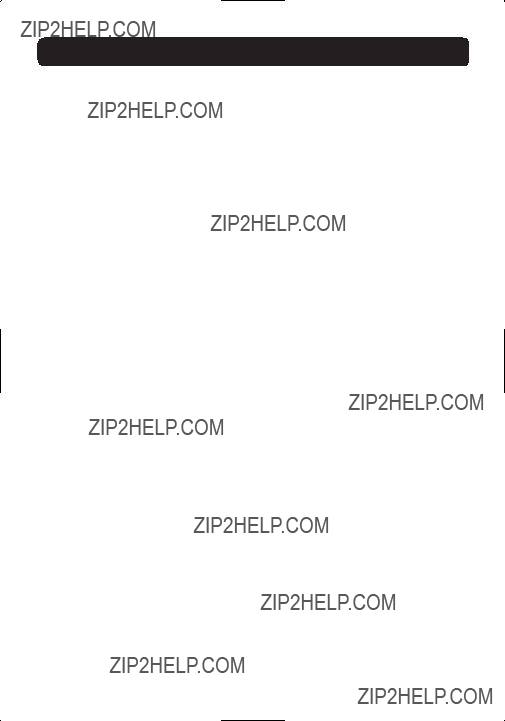
TROUBLESHOOTING
Print Servers in Windows XP or 2000, but not Windows 98. Check the Belkin website for compatibility issues at: http://web.belkin.com/support/F1UP0001.
???If none of the computers can access the Print Server, then either:
1.The Print Server has not been configured correctly (in this case, rerun the Setup Wizard);
2.Or, the printer you have connected to the Print Server does not support a
???Subnet warning??? error screen appears during setup
The subnet warning is generally associated with the existence of more than one network in the area. Subnet warnings occur when the Print Server has an IP address from one network domain, and the computer is on another network domain. The best solution in this case is to connect the Print Server to the network using an Ethernet cable and to configure it using the Setup Wizard. Then, after it has been configured into the correct subnet, disconnect the cable, and then reattempt the wireless setup using the Wizard.
If the Print Server has been configured before, and the IP address has already been set to another subnet, the best solution is to restore factory defaults on the Print Server. Do this by holding down the reset button while repowering the Print Server. After a reset, the Print Server will generally receive an IP address in the correct subnet.
???No printer??? error screen appears during setup
In most cases, this error occurs when the printer is not powered on, or it is not enabled (or online). After you have checked this, make sure that it is not out of paper or jammed. Some printers ???sleep??? after periods of inactivity. In any of these cases, restore the printer to functionality, then, if necessary, reboot the Print Server.
Some USB printers are not compatible with Print Servers. To check the Belkin website for compatibility information, go to: http://web.belkin.com/support/F1UP0001.
36

TROUBLESHOOTING
???Cannot communicate with printer??? or ???printer not found??? error message appears in Printer Driver Status Monitor
Again, this may result from the printer being powered off or from any of the issues mentioned above. Check that the printer is online, and make sure that it is not out of paper or jammed. Some printers ???sleep??? after periods of inactivity. In any of these cases, restore the printer to functionality, then, if necessary, reboot the Print Server.
If those issues are addressed and the problem still exists, Belkin recommends that the user disable the Printer Driver Status Monitor on the computer. The status monitor, a convenient checkpoint for the user, usually requires a direct connection between the computer and the printer. It may not communicate with the printer when connected to a print server on a network.
Instead, use the Windows ???Printer Status??? window to check printing status.
37

TECHNICAL SUPPORT
Find technical support information at support.belkin.com or www.belkin.com through the tech support link. For updated information on troubleshooting tips or for printer compatibility, use: http://web.belkin.com/support/F1UP0001.
Contact Belkin Technical Support by phone at
38

INFORMATION
FCC Statement
DECLARATION OF CONFORMITY WITH FCC RULES FOR
ELECTROMAGNETIC COMPATIBILITY
We, Belkin Corporation, of 501 West Walnut Street, Compton, CA 90220, declare under our sole responsibility that the product,
F1UP0001
to which this declaration relates,
complies with Part 15 of the FCC Rules. Operation is subject to the following two conditions: (1) this device may not cause harmful interference, and (2) this device must accept any interference received, including interference that may cause undesired operation.
Caution: Exposure to Radio Frequency Radiation.
The radiated output power of this device is far below the FCC radio frequency exposure limits. Nevertheless, the device shall be used in such manner that the potential for human contact normal operation is minimized.
When connecting an external antenna to the device, the antenna shall be placed in such a manner to minimize the potential for human contact during normal operation. In order to avoid the possibility of exceeding the FCC radio frequency exposure limits, human proximity to the antenna shall not be less than 20cm (8 inches) during normal operation.
Federal Communications Commission Notice
This equipment has been tested and found to comply with the limits for a Class B digital device, pursuant to Part 15 of the FCC Rules. These limits are designed to provide reasonable protection against harmful interference in a residential installation.
This equipment generates, uses, and can radiate radio frequency energy. If not installed and used in accordance with the instructions, it may cause harmful interference to radio or television reception, which can be determined by turning the equipment off and on, the user is encouraged to try and correct the interference by one or more of the following measures:
???Reorient or relocate the receiving antenna.
???Increase the distance between the equipment and the receiver.
???Connect the equipment to an outlet on a circuit different from that to which the receiver is connected.
???Consult the dealer or an experienced radio/TV technician for help.
Modifications
The FCC requires the user to be notified that any changes or modifications to this device that are not expressly approved by Belkin Corporation may void the users authority to operate
the equipment.
39

INFORMATION
The wireless radio of this device complies with RSS 139 & RSS 210 Industry Canada. This Class B digital complies with Canadian
Cet appareil num??rique de la classe B conforme ?? la norme
Radio products with the CE 0682 or CE alert marking comply
with the R&TTE Directive (1995/5/EC) issued by the Commission of the 
 0470
0470 
 European Community.
European Community.
Compliance with this directive implies conformity to the following European Norms (in brackets are the equivalent international standards).
???EN 60950 (IEC60950) ??? Product Safety
???EN 300 328 Technical requirement for radio equipment
???ETS 300 826 General EMC requirements for radio equipment.
To determine the type of transmitter, check the identification label on your Belkin product.
Products with the CE marking comply with the EMC Directive (89/336/EEC) and the Low Voltage Directive (72/23/EEC) issued by the Commission of the European Community. Compliance with these directives implies conformity to the following European Norms (in brackets are the equivalent international standards).
???EN 55022 (CISPR 22) ??? Electromagnetic Interference
???EN 55024
???EN
???EN
???EN 60950 (IEC60950) ??? Product Safety
Products that contain the radio transmitter are labeled with CE 0682 or CE alert marking and may also carry the CE logo.
40

INFORMATION
Belkin Corporation Limited Lifetime Product Warranty
Belkin Corporation warrants this product against defects in materials and workmanship for its lifetime. If a defect is discovered, Belkin will, at its option, repair or replace the product at no charge provided it is returned during the warranty period, with transportation charges prepaid, to the authorized Belkin dealer from whom you purchased the product. Proof of purchase may be required.
This warranty does not apply if the product has been damaged by accident, abuse, misuse, or misapplication; if the product has been modified without the written permission of Belkin; or if any Belkin serial number has been removed or defaced.
THE WARRANTY AND REMEDIES SET FORTH ABOVE ARE EXCLUSIVE IN LIEU OF ALL OTHERS,
WHETHER ORAL OR WRITTEN, EXPRESSED OR IMPLIED. BELKIN SPECIFICALLY DISCLAIMS ANY AND
ALL IMPLIED WARRANTIES, INCLUDING, WITHOUT LIMITATION, WARRANTIES OF MERCHANTABILITY
AND FITNESS FOR A PARTICULAR PURPOSE.
No Belkin dealer, agent, or employee is authorized to make any modification, extension, or addition to this warranty.
BELKIN IS NOT RESPONSIBLE FOR SPECIAL, INCIDENTAL, OR CONSEQUENTIAL DAMAGES RESULTING
FROM ANY BREACH OF WARRANTY, OR UNDER ANY OTHER LEGAL THEORY, INCLUDING BUT NOT
LIMITED TO, LOST PROFITS, DOWNTIME, GOODWILL, DAMAGE TO OR REPROGRAMMING OR
REPRODUCING ANY PROGRAM OR DATA STORED IN, OR USED WITH, BELKIN PRODUCTS.
Some states do not allow the exclusion or limitation of incidental or consequential damages or exclusions of implied warranties, so the above limitations of exclusions may not apply to you. This warranty gives you specific legal rights, and you may also have other rights that vary from state to state.
41

belkin.com
Belkin Tech Support
US: 877.736.5771 310.898.1100 ext. 2263 Europe: 00 800 223 55 460 Australia: 1800 666 040
Belkin Corporation
501 West Walnut Street
Compton ??? CA ??? 90220 ??? USA
Tel: 310.898.1100
Fax: 310.898.1111
Belkin Components, Ltd.
Express Business Park ??? Shipton Way Rushden ??? NN10 6GL ??? United Kingdom Tel: +44 (0) 1933 35 2000
Fax: +44 (0) 1933 31 2000
Belkin Components B.V.
Starparc Building ??? Boeing Avenue 333 1119 PH
Fax: +31 (0) 20 654 7349
Belkin, Ltd.
7 Bowen Crescent ??? West Gosford
NSW 2250 ??? Australia
Tel: +61 (0) 2 4372 8600
Fax: +61 (0) 2 4372 8603
?? 2003 Belkin Corporation. All rights reserved. All trade names are
registered trademarks of respective manufacturers listed. The 54g logo is a trademark of Broadcom Corporation in the United States and/or other countries.